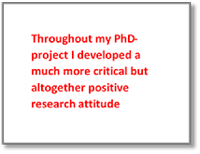 In this thesis different approaches are developed to make both indirectly fabricated molded tips and directly fabricated silicon tips, with a tetrahedral shape. Here, the three-sided planes of the tips result in a sharp apex of the tips.
In this thesis different approaches are developed to make both indirectly fabricated molded tips and directly fabricated silicon tips, with a tetrahedral shape. Here, the three-sided planes of the tips result in a sharp apex of the tips.
Advanced combinations of micromachining techniques were used such as deep reactive ion etching and anisotropic wet etching. ‘Novel atomic force microscope (AFM) tips fabrication routes are much sought-for,’ Rolf Vermeer says. ‘Both in scientific research - in several disciplines - and in strategic business R&D, AFM serves as an enabling technology.’

Several tetrahedral molded tip structures have been fabricated in (111) silicon. This led to well-defined flat tips with perfect triangular surfaces, as well as tips consisting of three smaller tips in one single plane.
‘Molding and deposition routes can also result in more robust tips as well, making use of ceramics, diamond or even polymer materials,’ Rolf Vermeer says. ‘By using silicon-nitride, ultra-sharp tips with radii as small as 3 nm were fabricated and successfully used in high resolution AFM measurements.’
Promising

In the other approach (direct fabrication), deep etching techniques were taken to the edge, making good use of the anisotropic crystal structures, and the tetrahedral crystal structure it all starts with. Corner lithography methodologies and wire frame structures, resulted in extra promising fabrication routes and schemes.
‘Throughout my PhD project I developed a much more critical but altogether positive research attitude,’ Rolf says. ‘Sometimes theoretically argued limitations can be overcome, by designing whole new fabrication routes. When first attempts to question these limitations fail, one can learn from that and be encouraged to look even deeper into the nature of phenomena actually taking place during the processes.’
Apertures

By combining schemes in a creative manner, tips with top apertures were fabricated with an inner diameter as small as 13 nm. ‘These could be used as minute membrane structures, or for microfluidic probes with sharp tips,’ Rolf enthusiastically shares. ‘In AFM research on soft/liquid samples, these tips might open up new measurement strategies.’
As a key moment in his PhD project, Rolf identifies his work on the molds: ‘After several attempts we started to learn into more detail to better understand and control the success factors for novel tip preparation. From that moment on the project speeded up, knowing what research direction to pursue and being able to work towards more complex structures and designs.’
NanoNextNL

The PhD project was part of the NanoNextNL program in which SmartTip (located in Enschede) served as an industrial partner. ‘I was happy to use their vast expertise on tip fabrication especially on microfluidic probes,’ Rolf says. ‘It is for sure some of the results of my work will be taken further, as they are promising for commercial use.’
The expert meetings with SmartTip and other NanoNextNL colleagues, helped Rolf to come to even better results. For example, his collaboration with professor Joost Frenken (University of Leiden) played a decisive role in characterizing tip performances. ‘Within Mesa+ several colleagues shared expertise, and inspired me, as well,’ he says. ‘Getting to know colleagues at the Mesa+ Day, and their work, helps one to share your own work and even tell about aspects that are bothering you and questions resulting from that. This openness is vital in gaining good results.’
Micronit
Already during the last stages of his PhD work, Rolf started working at another UT spin-off company: Micronit. ‘As a process engineer I hope to contribute to the R&D of the company, especially in the newly acquired capabilities of silicon processing for MEMS applications. I feel my process and fabrication skills, together with my experience in working in the cleanroom are advantageous, as are my modeling, designing and experimentation skills.’
